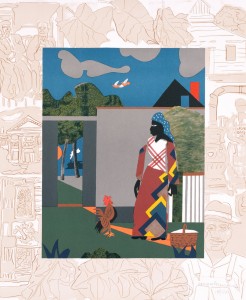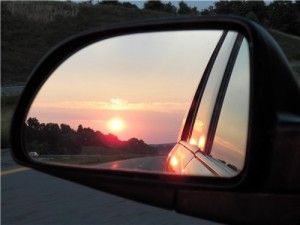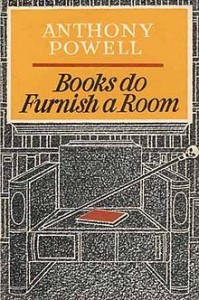 Mrs. T and I are thinking about adding another piece to the Teachout Museum, a lithograph by Romare Bearden, an artist whose work we both love, enough so that I’m surprised we’ve never before discussed the possibility of buying one of his prints. (Bearden is best remembered for his collages, but he was also a highly accomplished printmaker.) Though we already have a particular piece in mind, this isn’t something that we’ll do casually. Any art purchase, however modest the price, is by definition a big deal for us, and so we’re prepared to spend a considerable amount of time looking for just the right piece.
Mrs. T and I are thinking about adding another piece to the Teachout Museum, a lithograph by Romare Bearden, an artist whose work we both love, enough so that I’m surprised we’ve never before discussed the possibility of buying one of his prints. (Bearden is best remembered for his collages, but he was also a highly accomplished printmaker.) Though we already have a particular piece in mind, this isn’t something that we’ll do casually. Any art purchase, however modest the price, is by definition a big deal for us, and so we’re prepared to spend a considerable amount of time looking for just the right piece.
 Needless to say, it’s a lot easier to collect art if you’re rich, but I doubt that it’s more fun. In fact, I suspect that the necessity to pinch our pennies may well enhance the pleasure that Mrs. T and I get out of spending them on a work of art. I spent several years tracking down an affordable copy of the Childe Hassam lithotint that we acquired last fall, but it was worth the wait, and then some.
Needless to say, it’s a lot easier to collect art if you’re rich, but I doubt that it’s more fun. In fact, I suspect that the necessity to pinch our pennies may well enhance the pleasure that Mrs. T and I get out of spending them on a work of art. I spent several years tracking down an affordable copy of the Childe Hassam lithotint that we acquired last fall, but it was worth the wait, and then some.
When I tweeted about all this last week, Aaron Haspel, a Twitter-based aphorist, responded as follows: “Taste is quality divided by expense. Limited means provide unlimited opportunity to show it.” I can’t put it any better than that. If you can afford to buy whatever you want whenever you want it, you’re a lot more likely to pull the trigger casually, and your purchases may not be as reflective of such taste as you have. Mrs. T and I can’t afford to do that. Whenever we buy and hang a piece of art in our New York apartment, it’s because we love it enough to make a financial sacrifice in order to have the pleasure of looking at it every day, and everything we purchase is a direct reflection of our deepest aesthetic values. We believe in our shared tastes.
It remains to be seen whether Romare Bearden will join the roster of artists for whom we’re willing to make such a sacrifice. If he does, though, you can be sure that we’ll both feel confident that we did the right thing.



 Three years ago I posted an almanac entry drawn from an essay by
Three years ago I posted an almanac entry drawn from an essay by  • Gielgud’s Letters: John Gielgud in His Own Words
• Gielgud’s Letters: John Gielgud in His Own Words
 What does a young playwright have to do in order to be thought important? At 36, Amy Herzog appears to be well on her way to filling the bill. Though she has yet to make it to Broadway or win a Pulitzer, Herzog has written four plays that have been produced in New York and are currently being performed from coast to coast. Now Baltimore’s Center Stage, one of America’s leading regional companies, is mounting an “Amy Herzog Festival” in which her most successful plays, “After the Revolution” and “4000 Miles,” will be presented in repertory in productions directed by Lila Neugebauer. It’s the first time that the two plays, which share a central character and a common theme, have been done together.
What does a young playwright have to do in order to be thought important? At 36, Amy Herzog appears to be well on her way to filling the bill. Though she has yet to make it to Broadway or win a Pulitzer, Herzog has written four plays that have been produced in New York and are currently being performed from coast to coast. Now Baltimore’s Center Stage, one of America’s leading regional companies, is mounting an “Amy Herzog Festival” in which her most successful plays, “After the Revolution” and “4000 Miles,” will be presented in repertory in productions directed by Lila Neugebauer. It’s the first time that the two plays, which share a central character and a common theme, have been done together. Then as now, jazziness signified cultural sophistication, and most of Coleman’s hits featured the like-minded lyrics of Carolyn Leigh, who in “Witchcraft,” “The Best Is Yet to Come,” “I Walk a Little Faster” and “I’ve Got Your Number” wrote eloquently of the ins, outs, ups and downs of big-city romance: “Oh, yes, you’ll brag a lot,/Wave your own flag a lot,/But you’re unsure a lot,/You’re a lot like me.” Coleman’s heavily syncopated tunes fit her sexy sentiments like a bespoke sharkskin suit….
Then as now, jazziness signified cultural sophistication, and most of Coleman’s hits featured the like-minded lyrics of Carolyn Leigh, who in “Witchcraft,” “The Best Is Yet to Come,” “I Walk a Little Faster” and “I’ve Got Your Number” wrote eloquently of the ins, outs, ups and downs of big-city romance: “Oh, yes, you’ll brag a lot,/Wave your own flag a lot,/But you’re unsure a lot,/You’re a lot like me.” Coleman’s heavily syncopated tunes fit her sexy sentiments like a bespoke sharkskin suit….